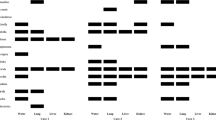Abstract
Forensic diatom test has been considered as a significant tool for diagnosis of drowning. Most of the studies in this field discussed the methodology of extracting, enriching and detecting diatoms from different tissues and drowning media. There are few studies on the basic principle of diatom test which was based on the theory developed by forensic scientists many years ago. This study was designed to analyze the length and width of diatoms in different organs and drowning medium samples of drowning cases. This study is designed to find evidence of diatoms penetrating the alveoli-capillary barrier. Samples from 100 drowning cases were analyzed using the methodology we developed: the Microwave Digestion-Vacuum Filtration-Automated Scanning Electron Microscopy method (MD-VF-Auto SEM method). The results showed that the length and width of diatoms in the liver and kidney tissues are smaller than that of the lung tissues and water samples. Our studies also found that the pennate diatoms are easier to penetrate through the alveoli-capillary barrier, travel in the blood stream and finally deposit in the distant tissues including liver and kidney. These findings provided evidences to support the process of diatoms penetrating the alveoli-capillary barrier.



Similar content being viewed by others
References
Auer A, Mottonen M (1988) Diatoms and drowning. Z Rechtsmed 101:87–98
Piette MHA, De EAL (2006) Drowning: still a difficult autopsy diagnosis. Forensic Sci Int 163:1–9
Pollanen MS (1998) Forensic diatomology and drowning. Elsevier, Amsterdam
Pollanen M, Cheung C, Chiasson D (1997) The diagnostic value of the diatom test for drowning, I. utility: a retrospective analysis of 771 cases of drowning in Ontario, Canada. J Forensic Sci 42:281–285
Lunetta P, Modell JH (2005) Macroscopical, microscopical, and laboratory findings in drowning victims. In: Tsokos M (ed) Forensic pathology reviews, vol 3. Humana Press, Totowa
Mueller B (1963) On the problem of the occurrence of diatoms in the organs of cadavers not having lain in the water. Dtsch Z Gesamte Gerichtl Med 54:267–272
Porawski R (1966) Investigations on the occurrence of diatoms in organs in death from various causes. J Forensic Med 13(4):134–137
Foged N (1983) Diatoms and drowning-once more. Forensic Sci Int 21(2):153–159
Hurlimann J, Feer P, Elber F et al (2000) Diatom detection in the diagnosis of death by drowning. Int J Legal Med 114(1–2):6–14
Giri BS, Tripathi CB, Chowdary YB (1993) Characterization of drowning by diatom test. Indian J Med Res 98:40–43
Lunetta P, Penttila A, Hallfors G (1998) Scanning and transmission electron microscopical evidence of the capacity of diatoms to penetrate the alveolo-capillary barrier in drowning. Int J Legal Med 111:229–237
Dettmeyer RB, Verhoff MA, Schütz HF (2014) Forensic medicine: fundamentals and perspectives. Springer-Verlag, Berlin
Zhao J, Liu C, He S, Lu S (2013) Microwave digestion-vacuum filtration-automated scanning electron microscopy as a sensitive method for forensic diatom test. Int J Legal Med 127(2):459–446
Niu Y, Zhao J, Xu L et al (2018) Separation of diatoms from digestive solution: a combination of membrane filtering and vacuum pumping. Australian J of Forensic Sci 50(4):361–370
Sunlin H, Jinfeng W, Xiaoting Z et al (2010) Using microwave digestion technique and scanning electron microscopy to detect diatoms in organs for the diagnosis of drowning. Chin J Forensic Med 25(3):145–149
Der RV (1904) Nachweis der aspirierten Ertränkungsflüssigkeit als Kriterium des Todes durch Ertrinken. Vierteljahresschr Gerichtl Med 27:274–279
Bajanowski T, Brinkmann B, Stefanec AM et al (1998) Detection and analysis of tracers in experimental drowning. Int J Legal Med 111:57–61
Tamaska L (1961) Über den Diatomeennachweis im Knochenmark der Wasserleichen. Dtsch Z Ges Gerichtl Med 51:398–403
Zhao J, Ma Y, Liu C, Wen J, Hu S, Shi H, Zhu L (2016) A quantitative comparison analysis of diatoms in the lung tissues and the drowning medium as an indicator of drowning. J Forensic Legal Med 42:75–78
Copenhaver WM, Kelly DE, Wood RL (1978) Bailey's textbook of histology. Williams & Wilkins, Baltimore
Acknowledgments
The authors gratefully thank Dr. Sherry Ma for her assistance in preparing the manuscript. This study was financially supported by Grant-in Aids for Scientific Research from Ministry of Public Security of the People’s Republic of China (2019SSGG0403).
Author information
Authors and Affiliations
Corresponding authors
Ethics declarations
Conflict of interest
None declared.
Ethical approval
The principles outlined in the Declaration of Helsinki were followed. The project was approved for human research by the ethics committee of Guangzhou Forensic Science Institute.
Informed consent
Informed consent was obtained from the legal representatives of the death cases.
Additional information
Publisher’s note
Springer Nature remains neutral with regard to jurisdictional claims in published maps and institutional affiliations.
Rights and permissions
About this article
Cite this article
Zhang, P., Kang, X., Zhang, S. et al. The length and width of diatoms in drowning cases as the evidence of diatoms penetrating the alveoli-capillary barrier. Int J Legal Med 134, 1037–1042 (2020). https://doi.org/10.1007/s00414-019-02164-4
Received:
Accepted:
Published:
Issue Date:
DOI: https://doi.org/10.1007/s00414-019-02164-4




